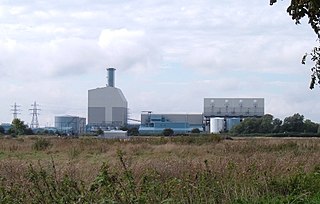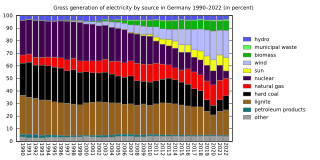Related Research Articles

Electricity generation is the process of generating electric power from sources of primary energy. For utilities in the electric power industry, it is the stage prior to its delivery to end users or its storage.

Drax power station is a large biomass power station in Drax, North Yorkshire, England, capable of co-firing petroleum coke. It has a 2.6 GW capacity for biomass and 1.29 GW capacity for coal. Its name comes from the nearby village of Drax. It is situated on the River Ouse between Selby and Goole. Its generating capacity of 3,906 megawatts (MW) is the highest of any power station in the United Kingdom, providing about 6% of the United Kingdom's electricity supply.

Fiddlers Ferry Power Station is a decommissioned coal fired power station located in Warrington, Cheshire, England. Opened in 1971, the station had a generating capacity of 1,989 megawatts and took water from the River Mersey. After privatisation in 1990, the station was operated by various companies, and from 2004 to 2022 by SSE Thermal. The power station closed on 31 March 2020. The site was acquired by Peel NRE in July 2022.

The IG Bergbau, Chemie, Energie is a trade union in Germany. It is one of eight industrial affiliations of the German Confederation of Trade Unions (DGB).

Energy in the United Kingdom came mostly from fossil fuels in 2021. Total energy consumption in the United Kingdom was 142.0 million tonnes of oil equivalent in 2019. In 2014, the UK had an energy consumption per capita of 2.78 tonnes of oil equivalent compared to a world average of 1.92 tonnes of oil equivalent. Demand for electricity in 2014 was 34.42 GW on average coming from a total electricity generation of 335.0 TWh.

Aberthaw Power Station refers to two decommissioned coal-fired and co-fired biomass power stations on the coast of South Wales, near Barry in the Vale of Glamorgan. They were located at Limpert Bay, near the villages of Gileston and West Aberthaw. The most recent power station on the site, Aberthaw B Power Station, co-fired biomass and as of 2008 had a generating capacity of 1,560 megawatts (MW). The power station closed on 31 March 2020.

Thunder Bay Generating Station is a defunct biomass-fired thermal power station owned by Ontario Power Generation ("OPG"). It is located on Mission Island in Thunder Bay, on the shore of Lake Superior.

Solar power accounted for an estimated 8.2 per cent of electricity in Germany in 2019, which was almost exclusively from photovoltaics (PV). About 1.5 million photovoltaic systems were installed around the country in 2014, ranging from small rooftop systems, to medium commercial and large utility-scale solar parks. Germany's largest solar farms are located in Meuro, Neuhardenberg, and Templin with capacities over 100 MW.

A coal-fired power station or coal power plant is a thermal power station which burns coal to generate electricity. Worldwide there are over 2,400 coal-fired power stations, totaling over 2,000 gigawatts capacity. They generate about a third of the world's electricity, but cause many illnesses and the most early deaths, mainly from air pollution.

China is the largest producer and consumer of coal and the largest user of coal-generated electricity in the world. The share of coal in the Chinese energy mix declined to 55% in 2021 according to the US Energy Information Agency.

King's Lynn Power Station refers to a combined cycle natural gas power station near King's Lynn in Norfolk, commissioned in 1997, and now owned by RWE, and to a coal fired power in King's Lynn in operation from 1899 to 1960. The CCGT station was mothballed on 1 April 2012. It can generate 325 MW of electricity and employed 40 people. The site was reopened on 19 November 2019.

Germany predominantly sources its energy from fossil fuels, followed by wind, nuclear, solar, biomass and hydro.
Romania is the 38th largest energy consumer in the world and the largest in South Eastern Europe as well as an important producer of natural gas, oil and coal in Europe.

The Wilton power station refers to a series of coal, oil, gas and biomass fired CHP power stations which provide electricity and heat for the Wilton International Complex, with excess electricity being sold to the National Grid. It is located on the Wilton site in Redcar and Cleveland, south of the town of Middlesbrough in North East England. The station has provided for the site since opening in 1952, when it was operated by ICI. The station is currently owned and operated by SembCorp Industries.

Coal phase-out is an environmental policy intended to stop using the combustion of coal in coal-burning power plants, and is part of fossil fuel phase-out. Coal is the most carbon-intensive fossil fuel, therefore phasing it out is critical to limiting climate change and keeping global warming to 1.5 °C as laid out in the Paris Climate Agreement. The International Energy Agency (IEA) estimates that coal is responsible for over 30% of the global average temperature increase above pre-industrial levels.

Germany's electrical grid is part of the Synchronous grid of Continental Europe. In 2020, due to COVID-19 conditions and strong winds, Germany produced 484 TW⋅h of electricity of which over 50% was from renewable energy sources, 24% from coal, and 12% from natural gas. This is the first year renewables represented more than 50% of the total electricity production and a major change from 2018, when a full 38% was from coal, only 40% was from renewable energy sources, and 8% was from natural gas.

Mátra Power Plant, is a lignite fired power plant majority owned by MVM, the Hungarian state owned power company since 2019. It is located in the valley of the Mátra mountains, in Hungary. It has an installed electric power output of 950 MW, however, one 200 MW generator has been on permanent hiatus since January 2021. According to the latest government energy strategy, most of the existing lignite-fuelled units will be shut down in 2025, and a new 500 MW gas-fired unit will be added as well as up to 400 MW in solar power.

The Afşin-Elbistan power stations are coal-fired power stations in Afşin in Kahramanmaraş Province in Turkey. The area is a sulfur dioxide air pollution hotspot: Air pollution can be trapped by the surrounding mountains, and Greenpeace say that measurements they took nearby in late 2020 show illegal levels of particulates and nitrogen oxides. The Environment Ministry has not released the flue gas measurements.
Afşin-Elbistan C was a planned 1800-MW coal-fired power station which was proposed to be built in Turkey by the state-owned mining company Maden Holding. Estimated to cost over 17 billion lira, at planned capacity it would have generated about 3% of the nation's electricity. According to the environmental impact assessment (EIA) the plant would have burned 23 million tonnes of lignite annually, and emit over 61 million tonnes of CO2 each year for 35 years.

Coal in Turkey generates between a quarter and a third of the nation's electricity. There are 54 active coal-fired power stations with a total capacity of 21 gigawatts (GW).
References
- ↑ Daniel Wetzel (4 March 2021). "Phänomen Dunkelflaute – Der Kohle-Ausstieg hielt nur acht Tage". Die Welt (in German). Retrieved 15 April 2021.
Die Anlage, die seit ihrer Abschaltung am Neujahrstag noch in ständiger Betriebsbereitschaft gehalten wird, musste auf Ersuchen des Netzbetreibers Tennet seit dem Jahreswechsel bereits sechsmal wieder hochgefahren werden
- ↑ "Bundesnetzagentur prüft Anträge zu systemrelevanten Anlagen der ersten Ausschreibung zum Kohleausstieg" (in German). Bundesnetzagentur. 2021-03-04. Retrieved 2021-03-18.
- ↑ "Energie-Knappheit: Kraftwerk im Kreis Minden-Lübbecke geht wieder ans Netz" [Energy shortage: power plant in the Minden-Lübbecke district goes back online]. www.nw.de. 24 August 2022. Retrieved 24 August 2022.
52°22′55″N8°59′54″E / 52.38194°N 8.99833°E